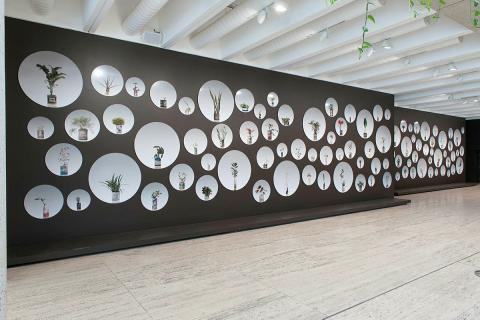ROSENO, Edwin; Green hypermarket (series)
By Tarun Nagesh
Yogyakarta-based photographer Edwin Roseno is an active member of the young generation of Indonesian artists that were highlighted in the recent Asia Pacific Triennial of Contemporary Art (APT7). He is the manager of MES56, a prominent Yogyakarta photographic project space, and is at the forefront of contemporary Indonesian photography.
Roseno’s most ambitious project to date, created especially for APT7, ‘Green hypermarket’ 2011–12 consists of 150 images that feature combinations of everyday materials — plants and consumer packaging — to question the relationships and associations they have in our lives. Using cans, bottles, cartons and plastic containers he bought in supermarkets, Roseno potted a variety of plants sourced from friends, neighbours and local nurseries. The photographs present the symbolic dichotomies of natural and manufactured, renewable and discarded, local and global, ancient and modern.
The fundamental human need for food was the basis for Roseno’s project. Through it he investigated the food production process from its simplest means to global mass-manufacturing, revealing the industry’s inherent health and environmental implications. However, these curious images are not solely a commentary on consumerism; the contrasts are often beautiful and ethereal as they hover in a constellation of circular panels, harmonising fragile natural forms with the glossy texture and rigidity of discarded synthetic objects, now degraded and empty. Some provide elegant aesthetic compositions: tall cactus spines push skyward from a discoloured round chocolate-wafer tin; the long green leaves of a yucca extend out in every direction from a brightly coloured Blue Band margarine container; and the delicate fronds of the Premna microphylla sprout from the bold graphics of a can of Spam. Other couplings can be read with more symbolic connotations. For example, a Coca-Cola can, which sports the brand of one of the most recognisable global corporations, grows a shrub of bamboo, a plant treasured across Asia and the lifeblood of many communities; while a small, humble cactus with fine thistles emerges from a Campbell’s soup can, considered the icon of the Pop art movement.
By borrowing plants to make his images, Roseno was forced to engage with his local community, a process he found very important to the project and through which he gained further knowledge of local plants, including those useful for food and medicine. Whether indigenous or introduced, these plants had been grown in his local environment, nurtured by an owner and grow in response to the seasons; the containers, however, whether from global brands or Indonesian companies, are abundantly available, with their ingredients, production process and origin often foreign and disconnected from any single location.
Imagery of commercial branding is now an inescapable part of urban life and can evoke nostalgia as well as consumer desire. Plant life can also evoke a sense of belonging or familiarity. In this way, Roseno’s images contrast our emotional connections to both, with the realisation that some consumer icons are more recognisable than many plant species — perhaps the work suggests that we appreciate plants for their aesthetic quality, but that their role in the food we eat is either absent or removed from our conscious thoughts through commercial production. ‘Green hypermarket’ is a poignant reminder of economic and environmental tensions that are increasingly relevant today, particularly in the growing economies of Asia where urbanisation, globalisation and mass consumerism have evolved rapidly, and younger generations can grow up in societies no longer functioning through traditional or local customs.
Tarun Nagesh, Artlines 2-2013, p.39.
